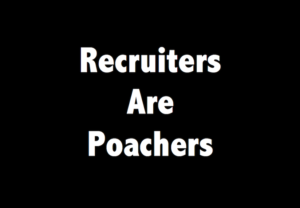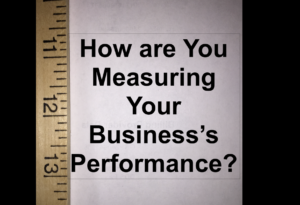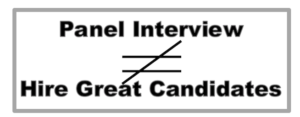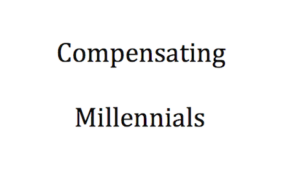Who is Calling the Recruiter a Poacher?
Websters dictionary defines poachers as “Someomeone who trespasses or steals”. While I believe that today’s hiring process is broken and many members of the recruiting community would benefit from a simple lesson in ethics, it is virtually impossible for any recruiter to “steal” an employee.
In my experience, the label of poacher has been given to recruiters by weak and ineffective business leaders. Recruiters are only poachers in the minds of the business leader who believes that he or she holds some ownership of their employee.
This is not about recruiting. The suggestion that recruiters are poachers is really a leadership issue !
Today’s At Will Workplace
The capitalistic model of today’s workplace states that an employer can choose to end the employment relationship and the employee can choose to leave their employment.
While hiring critical talent is not easy, leaders hold the responsibility to motivate their team members and provide a purpose and a reason for employees to want to contribute to their organization. The role of a CEO or business leader is a difficult one. But, leaders need to be leading their organization.
If today’s workforce were to be divided into one of two parts, one part would be glued to their job and the other part would be loosely connected to their job. The companies that have most of their employees glued to their job are the companies that practice good leadership everyday and are ahead of their competitors.
I have been at events where a CEO approached me and said: “Don’t poach my people”. My response was: “I am not your problem. You probably need to look in the mirror. If your employees are loosely connected to their job, they are just waiting for a better opportunity. Ask yourself what are you doing everyday that makes your employees want to come to work”.
The New Normal Combined with True Leadership
There was a time when employees retired from the same employer after 30 years. Today’s new normal is every 3-5 years an employee changes jobs. Sometimes, it’s an even shorter period than that. The new normal is that rarely can a leader expect to have the services of an employee for 30 years.
Knowing that turnover is almost a certainty, leaders should be continuing to develop existing talent and continuing to acquire critical talent. The really great employees are going to be offered a higher compensation and a compelling career path that your business can’t compete with.
The new normal combined with true leadership is:
– Understand that employee turnover is an almost certainty
– This also means that it should be easier for your company to acquire talent, since the supply side is active
– As a true leader, encourage your employees to grow and pursue their ambitions. They are going to do it, with or without your support.
– By supporting them, you will be more likely to know that they may be considering another employment opportunity and you will therefore be less likely to be surprised by their departure and have to replace them in a reactive mode.
– By supporting their ambitions as a true leader, you will have the basis for a long term relationship with great talent.
– The key point is that they don’t have to be your employee in order for them to be valuable to you. If your have been a selfless leader, your ex-employee might become your best customer or your best supplier or your best advocate in your business sector.
If you have adopted the philosophy of this new normal, it would be impossible to think of the word poaching as it relates to the employees working at your organization.
Good hunting
Hiring SHOULD be easier than it is
Mankind has been hiring critical talent for a long time. There are companies who have been around for as long as 500 years. The business itself is almost as ubiquitous as air. By now, the activity of hiring critical talent should be fairly easy.
But it is not easy. Why?
In my experience, today’s hiring model is broken. Job seekers struggle to navigate their way to being hired for the right role and businesses to struggle to acquire the right talent. Yes, of course, successful hiring is occurring but even a broken clock gets it right twice a day. A broken clock is not the result of a reliable process or a proven approach.
So, why is hiring so hard today?
Here are three reasons:
I) The complexity of humans
II) Unlimited amount of poor advice
III) Lack of understanding of hiring models
I) Complexity of Humans
Our society is constantly looking for faster, more efficient methods to turbocharge an outcome. Technology has delivered many great tools. Hiring is the exception to almost any other transaction as it requires a deliberate, two-way human investment. Regardless of the complexity of the product or service your company delivers, there is nothing more complicated than the people who work for your company or the people who you would like to work for your company.
Less attention is being given to the human, psychological aspect of hiring when much more attention should be the direction.
Turbocharging the hiring process with the technical tools or shortcuts that have been developed ends up reducing the critical human interaction factor. It turns the hiring process into nothing more than another transaction. It prevents an important connection from forming between the hiring manager and the newly hired talent. It prevents the hiring manager from hiring the talented candidate who meets the basic technical requirements while is also the best cultural fit or the most “likable”.
Hiring managers must be hiring people who they like and believe can succeed. Candidates must be working for someone who they want to work for and feel some sort of human connection. Too many of the tools today are being allowed to replace this interaction and too many hiring managers are not making it a priority to participate directly in the hiring of the people who report to them.
II) Unlimited amount of poor advice
If you want to learn about interviewing or about how to get a job, just ask anyone within earshot. Everyone has an opinion and everyone is an expert. You can also Google how to answer interview questions and practice all of the traditional interview questions, then learn the scripted answers and commit them to memory. Congratulations, now you are a parrot, not a candidate!
You could become a search word expert, insert all of the right search words into your resume and then post your resume into the various job boards. Wait, let’s look at this from a cynical view. What if a 20 something-year-old was a search word expert who developed the greatest search word resume and then applied to the same job as the mother or father who had years of demonstrated experience, would it make any sense that the 20 something should be considered over the much more qualified, experienced alternative?
Then there is an industry that targets job seekers, telling them for a fee they can get the job seeker a great job. Sadly, this is not plausible and is more about taking advantage of the unemployed who are hearing a fairy tale.
While there is an abundance of advice and abundance of hiring experts, how much of the advice is coming from qualified sources?
Questions to ask that offering advice might include:
“When was the last actual hire that you were directly involved in?”
“What is the number of hires that you have been directly involved in during the past 12 months?”
“What type of hiring positions are you directly familiar with?”
III) Lack of Understanding the Hiring Models
When you think of hiring, you probably think of Human Resources, Recruiters, LinkedIn, and job boards. It goes much deeper and most business leaders along with most job seekers have failed to obtain a real understanding of how all of the various models really work.
First of all, today’s business world is constantly changing. Business must be nimble and agile. Roles and responsibilities are changing and the size and growth capabilities of every business is changing.
There was a time when a Human Resources professional was on the front line for hiring. Today, that professional needs to be a benefits expert, an employee relations expert and is concentrating a lot of their time on internal administrative functions, leaving very little time to devote to outward facing recruiting and hiring. Things have gotten so bad that I rarely if ever hear an interviewee tell me that they met with HR and found it to be an enjoyable experience. This is the department that has the first name of “human”. The human interaction should be the best thing they do.
As for LinkedIn and the job boards, I am active on LinkedIn but it is not a hiring solution. How could it be when it is limited to being online? LinkedIn and the job boards should be regarded as tools, nothing more. Someday, they may be replaced by better tools.
The recruiting models exist in multiple forms. The name “Executive Recruiter” is now being applied to almost any type of recruiter because it gives the recruiter some perceived credibility.
To make this simple, today’s traditional recruiting model is largely to blame for today’s broken hiring model.
Most recruiting models have a fee structure that is directly tied to the compensation paid to the candidate being hired. In many cases, there is NO fee paid to the recruiter unless that recruiter’s candidate is hired.
This model does not align the true needs of the business to acquire the right fit. This model means that it is more important to the recruiter that their candidate gets hired then it is to the hiring company or it is to the candidate. Remember, the best talent is not necessarily the highest paid candidate.
Steps to consider as a business leader or hiring manager would include taking a little time to audit and objectively gain a first-hand appreciation for what a candidate goes through when being considered for a role in your organization. How would you feel if it were you?
Worth noting, I will be on a speaker’s panel at the Small Satellite Symposium on Thursday, Feb 8th, 2018 discussing business growth and the challenges facing small companies to grow by acquiring the right talent.
For more information about Boxwood, please click here.
Good Hunting!
What Does Compensation have to do with Great Hiring?
Is compensation really all about the money?
As a business leader, are you highly confident that when you pay your employees a significant flat salary, that you will receive a significant performance from each and everyone of them? Are you just as confident that when you hire them, they will know exactly what to do in their role as a new member of your company? Shouldn’t a compensation process be in place to acknowledge and reward for outstanding performance that would also serve as a motivator?
Today’s hiring process is broken and there is no reason to think that things will immediately change in 2018. Employers will continue to be bombarded with a deluge of quick hiring snake-oil propositions and job seekers will continue to think that if they submit their resumes to job boards and recruiters that the perfect job will arrive on their doorstep.
Employers repeatedly overlook the most complicated and complex component of business today which is the people who work for your business and the people who your business wants to hire. Great hiring requires an appreciation for the talent including an appreciation for measuring and rewarding performance.
It has been recently reported that we have reached a 17 year low in the unemployment rate (See CNN video)which suggests that employers will need to implement a true hiring process more than ever in order to identify, attract and hire the right talent. Once they have completed that achievement, employers need a process for rewarding and retaining the talent they have worked so hard to recruit.
So, what does compensation have to do with great hiring? No, it is not all about the money. The best hire is not necessarily the highest paid. (Click for recent column) But it is about measuring and rewarding an employee for their efforts and for their performance.
Let’s discuss the compensation disconnect and a path forward.
Why is there a compensation disconnect?
The compensation patterns that I have seen most commonly involve the company’s profitability being shared with the employees. “When the company is profitable, employees will receive a bonus”. This is a very easy model to establish. It is a model that does not require much time to measure or implement and therefore consumes a minimal amount of managerial resources. It is a model that serves the executive leadership well.
As for the employees, this is a model that makes them uncomfortable and does not measure or reward them for their individual contributions to their employer.
The disconnect occurs thanks to the blind spot that many CEO’s have when it comes to compensation. They feel that what is good for them (profitability) is also good for their employees. Only a small percentage of the members of any company are decisions makers of the company’s true profits after operating expenses. The remaining employees are at the mercy of what they perceive to be an arbitrary compensation bonus.
How to compensate for great hiring during a low unemployment rate
Compensation is another word for reward. In the simplest of terms, as a business leader, aren’t you rewarding your employees for delivering value to your organization by their doing their job well?
A few key points:
1) Compensation for great hiring should involve the development of a process that works during all times. Define the specific objectives or goals the employee will accomplish. Assign a defined value to the goals and reward the employee when the goals are met. Establish a rolling 3-6 month cycle when the goals are revisited and refreshed.
2) Yes, clearly defining the specific roles and responsibilities of each employee is a time-consuming step that demands focus, but then no one said that running a successful business and hiring great talent was easy.
3) If your hiring process is influenced by the unemployment rate, then you are focused on hiring active (or unemployed candidates) versus hiring passive (or actively employed candidates). These represent two very different audiences. In general, it is much more time consuming to pursue, attract and hire employed candidates and they generally make a better hire.
4) Rewarding employees for their performance does not have to be limited to monetary rewards. Rewards can also include simply the recognition that the employee has delivered outstanding value to the company. A simple “thank you” can go a long way as a recognition of good work.
In summary, compensation is the result of either a well constructed, process-oriented rewards program or it is an ineffective, loosely defined employee payout plan that promotes mediocre performance.
It is hard to attract and retain great talent without clearly defining their role and clearly rewarding their efforts.
What is your business doing today to attract and retain top talent while focusing on outperforming your competition and over-delivering to your clients or customers?
Good hunting
Please click here to contact Boxwood to discuss your needs for great hiring.
Clothes look better than naked
It has been said that the general public looks much better with clothes on versus clothes off.
Perhaps the same can be said for most companies. Once the business becomes stripped down, blemishes and warts become visible. The imperfections are on display.
Doesn’t the revealing of the naked truth expose a lot about the company and how well it is running?
Let’s discuss two diverging paths in an organization between the employees and executive leadership with a simple approach toward the rectification and the return to organizational alignment.
What is the reaction to the naked company through the eyes of the employees?
What is the reaction to the naked company through the eyes of the executive leadership?
In a perfectly aligned organization, everyone would see the same blemishes and would be working together to address the challenges of the business.
Reaction of Employees
At the core of every business, each employee should be solving a business challenge or business problem for their company. Employees aren’t really necessary if the business is perfect in every way and has no business challenges. Most of the business problems that employees face in their day-to-day jobs are clearly identified and defined issues. As talented and critical employees do their respective job, they frequently uncover the deeper issues or the company’s blemishes and warts. These deeper issues take many forms from weak leadership to poor execution to a non-existing employee rewards program.
Once they have seen the stripped version of their company, employees can quickly become disenchanted. Some will leave for what they regard as a better opportunity at another place of work. Some will attempt to express their concerns within the communication channels of their company. Some will step-up and attempt to correct the deeper issues.
Regardless, the workforce holds a first-hand perspective of the deeper challenges the company is facing.
Reaction of Executive Leadership
For startups and small businesses, most executives are able to remain in front of the blemishes and warts. The workforce appreciates working in a setting where there is a common view of the business challenges needing attention.
At some point, the business is no longer just a startup or just a small business. Managing in the larger organization is different. For many executives, there is no time for them to view their company in a naked state. For them, they may no longer be able to see their company naked which is a sign that the company has slipped out of alignment. As a result, operational efficiencies are less effective and competitive advantages have shrunk.
Rectification
Rectifying the issue is a simple one and timely. As we are headed into a new year, what better time for the executive level to formally or informally conduct an evaluation? After all, those critically talented and hard-working employees have a firm grasp on the issues.
Without making it a complicated process, ask the employees for their scorecard. What is working, what is not working, what needs to work better. By employees and executives sharing the same view of the blemishes and warts, issues can be addressed leading to the return of the alignment of the business.
Good hunting
(1 of 4) Filling a Position or Solving a Business Problem?
What are the most common recruiting errors and how can they be fixed? (This is the first of a four-part answer.)
The hiring world is broken. The stakes are high and hiring the right talent can really deliver measurable value to the growth and success of an organization. On the other hand, the costs of a failed hire are very expensive and can move an organization backward while also damage the career path to the aspiring business professional who was the subject of the failed hire.
Best practice recruiting is a process that requires giving attention to multiple steps in succession. There are opportunities for errors along the way.
Regardless of the complexity of your company’s product or service, there is nothing more complicated and complex than the people who work in your organization and the people who you would like to add to your organization.
Does Your Recruiting Terminology Contribute to Recruiting Errors?
How does your organization communicate a recruitment? The words your company is using to describing hiring tells a lot about your organization. The choices of wording used to add critical talent to your organization broadcasts your company’s philosophical view and attitudes toward the people who run your company and to the people who you would like to attract to your company.
Is your company using:
- Filling a slot
- Placement
- Staffing
- Personel
- Position Spec
- Resume keyword searching
- Putting a warm body in a seat
OR ..Is your company using:
- Solving a business challenge/business problem
- Our structured and proven hiring process
- Making sure we get the right person with the technical skills who fits our culture
- Talent
- Business professionals
- Detailed position description
Define The Problem to Prevent Recruiting Errors
Shouldn’t best practice recruiting be the result of hiring a professional to solve a business challenge or business problem?
It is my experience that the process to hire the right talent must start from within the organization. First, the hiring manager needs to define and declare the business problem that newly hired talent would solve. Then, that problem must be outlined in a position description along with the required experience needed for someone to solve it.
Too many times in our broken hiring world, I see a business leader say something like, “We really need to add someone and I’ll know the right person when I see them”. Or ,”Our problem is that we need to hire someone”.
It is possible that in an earlier period of the history of business when things ran at a slower pace and the efficiency of an organization was less important, filling a position or putting a butt in a seat was fine.
Our business landscape is constantly changing. Nimble and agile are required today. If your company is using outdated recruiting terminology or an outdated approach, you may be finding that great talent is being hired by your direct competitors and you may also find that some of the best talent in your company is leaving to go work for your competitors.
Note: Part 2 of 4 “How to prevent recruiting errors” will be published next
Good Hunting
For more information about Boxwood Strategies, please click here.
Our approach to recruiting.
Success Business and Sales Hunting Require Effort
I don’t think we can afford to view business as a passive event. Business involves the investment of effort, an openness for change and an appreciation of the power of momentum. Sales hunting is an active event. Selling is an art (please click). Business involves human beings who participate in a variety of roles from executive leadership on down.
For the business role of the sales producer, they obviously need to be actively pursuing or hunting for revenue-producing sales opportunities. Sadly, even some members of the sales community have been known to take the passive approach as they may wait for the phone to ring.
Many members of the business community do not regard their personalities or their roles as hunters. For example, the accounting department or the manufacturing team or the administrative members of your business do not come to work thinking of themselves as being in the role of hunting.
I frequently hear people complaining about the poor service they receive when requesting assistance from customer service. Here is an obvious example of an opportunity to drive customer loyalty and growth by having the reputation for great customer service. Great customer service requires effort. Isn’t this sales hunting?
Perhaps as the business leader, you may not think of them as having a hunting role. If you don’t see them that way, they will never see themselves that way.
The difference between good and bad businesses
If you take a hard look at all businesses, the difference between the really good ones and the really bad ones can be a matter of just a few degrees. Gaining a competitive advantage based solely on attitude can make all of the difference.
Despite new technologies automating our world every day, people still are doing business with the people they want to do business with.
Good Hunting can be defined differently by the sales team versus the administration department.
Questions to ask
When it comes to running your business:
– Is your business focused on targeting, attracting and acquiring the right new clients or new customers?
– Has your business prioritized taking care of your existing clients or customers? It is harder to get a new customer than to keep an existing one.
– Is your business focused on seeking and developing business relationships with the right business partners?
– Is your business taking an active approach to identifying, attracting, pursuing, and hiring the right talent?
– Has your business developed a transparent, straightforward program to define employee goals, measure individual results and reward for performance?
What level of success would you give to your business as it relates to Hunting?
If you can’t award a high rating, then it is possible that your competitors have the edge.
How committed is your business to hunting?
Good Hunting !
To learn more about Boxwood, please click
Do your employees have business focus?
As a business leader, you are constantly challenged with navigating your business through obstacles and finding a path for success. It is necessary to measure business focus on both the immediate goals as well as the goals on the horizon. There are numerous resources that define good leadership (click for example) and offer recommendations for improvement (click for example), but shouldn’t you make sure that your business has what it takes today before you go forward? Is everyone in your organization just as focused and just as excited about the business as you are?
The only thing constant about today’s marketplace is that it is changing and will continue to change. While everything in your business may have once functioned well, shouldn’t you check-in or validate that the members of your organization continue to be focused, motivated and on-message so they are delivering their best performance for you and the organization? Are you the business leader taking things for granted?
Here are two areas that could offer simple insight to measuring the feeding and caring for top employees
Is business focus part of the value from the employee compensation plan?
It is no longer a good use of the company’s valuable resources to simply reward employees with a salary or with a bonus based solely upon the company’s profitability. If your company is paying for payroll, it should be viewed as an exchange for measurable services received instead of an entry on the company’s expense sheet.
As with anything, it takes an effort to get the best results. If your business simply pays out a base salary, there is not much effort in the measurement and calculations to compensate the employee. At the same time, there is little to no motivation for the employee to deliver their best performance since employees delivering a weak performance are getting paid through the same measurement as great employees. As for bonuses paid based upon profitability, there is a relatively tiny percentage of members of your company who have any direct influence on EBITDA or simple profitability. Everyone else is receiving an arbitrary bonus.
What’s is wrong with an arbitrary bonus? Everything is wrong with it. It is an expense to your company, not an exchange for measurable services received. Does great work from every employee necessarily lead to a higher percentage of profitability on the bottom line? Of course, it can’t which is why profitability alone is a poor measurement choice.
As for the actual payment or reward for performance in the form of a bonus, if your company is delaying the payout for 12 or more months, what employee will remember the great work they delivered 10 or 11 months earlier once they finally receive their bonus? Again, this bonus serves the employer as nothing more than an expense. The employer might as well just throw the money out of an open window.
Are you measuring your company’s employee compensation?
The answers can be found standing right in front of the business leader. The question to be asked to a sampling of low to mid to senior level employees is:
“Would you explain to me (the business leader) how you (the employee) are specifically paid your performance bonus?” The answer from the employee should include what they need to deliver in their performance in order to earn their bonus and when they can expect to be paid. Unless each employee can quickly and accurately respond, your business could be operating more effectively. Is everyone just as excited about the business as you are? Do they understand the business’s focus?
Is your business focus aligned to solve your biggest challenge?
Communication is a word commonly used by all organizations. I worked for a global company who coined their tagline as “Engineering the flow of communications”. In my experience, communications are challenging for organizations to effectively implement. For example, if the leadership has become lulled into believing that their corporate momentum is rolling along, then there is a lesser focus to drive the company message out to all members of the organization. If the members of your business are no longer aligned with their respective efforts, then the business will no longer receive the best performance and most effective performance from its workforce.
Again, the answers can be found standing right in front of the business leader. The question to be asked to a sampling of low to mid to senior level employees is:
Are you measuring your company’s biggest challenge?
“Would you tell me in a couple of sentences what is the biggest challenge that our company faces today? “Would you also tell me why this is your answer and what that company is doing to address this challenge?” “Finally, would you tell me what you, as an employee of this company are doing to address the issue?”
Are both your employees and your business focused on solving the biggest challenge?
Obviously, with good communications from the leadership along with good alignment, the employee responses should be consistent with each other and be accurate.
In Summary
If running a business were easy, everyone would be doing it with unlimited success. It is invaluable for the leaders of businesses to check-in and validates that things are running as well as you would like them too.
Ask yourself:
– Are you confident that your employees are performing at their best, aligned with the business” focus and being measurably rewarded for it?
– Are you confident that everyone in your organization is aligned with their individual role to address the company’s biggest challenge?
– If you are not sure, the response may be a surprise but will only serve as the foundation to be a better leader and to improve your company.
Good hunting.
Need help aligning employee compensation with the company’s goals and business focus?
Panel Interview’s two sides to consider.
As a CEO or business leader, adding the right talent to your business through the most efficient means is a top priority. Panel interviews are an efficient use of time since all members of the hiring jury are interacting with the candidate at once. However, interviewing requires both an employer as well as a candidate in order to successfully complete the two sides of interviewing. Since the most complex and complicated part of every business is the people who work there, how much thought is given to the candidate when using the panel interview format? The internet offers pages and pages of preparation tips for candidates. Hiring great talent requires attracting great talent. Does the panel format attract the right talent to your business?
We frequently see panel formats on TV when individuals are being interviewed by panel members of our government and in reality shows.
Let’s explore the key issues to see how panel interviewing can help your business hire great candidates.
Panel Interviews from the business’s view
– Multiple people all interviewing the candidate at once
– Efficient use of time
– Effective multiple interactions
– Observers can study responses such as body language and tone
– Really tough interview questions can be asked by the group, providing group insight based upon the candidates’s response
Panel Interviews from the candidate’s view
– Candidates often describe their feelings leading up to a panel interview as being nervous, stressed out and uncomfortable. There is a vast amount of panel interview preparation available to candidates. For example, here is an article describing the panel interview as “The Firing Squad”. In this article, ambush is used to describe the panel interview.
– With the panel format, candidates might be spending more time rehearsing for the predicted interview questions than spending time researching your company and trying to best understand how they can solve the business challenge that would help your business.
– From the candidate’s perspective, your candidate may even view the panel as if the candidate is preparing for battle. Ask yourself, is your business hiring for cage match or mixed martial arts competitors? Let’s not lose sight of the purpose of best practice hiring. It is a business event where your business needs critical talent to solve a business challenge while also fitting the culture of your company.
– Remember, being a candidate is difficult enough without being put into battle mode.
How to Hire Great Candidates Using Panel Interviews
– The panel interview approach will not lead your business down the road of hiring great candidates.
– Your business is reducing the chances for successfully hiring great candidates with the use of panel interviews.
– The firing squad feeling that candidates experience suggest to the candidate that your business has little concern for a true candidate interaction.
The panel interview model delivers candidates who have fully rehearsed answering the predictable questions instead of candidates who are focused on solving your business challenge.
What is the best approach?
– Take the time to have qualified candidates meet individually with each member of the hiring jury. Yes, this will be perceived as taking more time. However, if each member of the hiring jury is spending an hour in a panel setting to meet with a candidate, then the same hour could be spent by each interviewer, only on a one-to-one. The one-to-one setting gives the candidate an opportunity to experience the company culture along with some personal interaction. Developing a personal connection for the candidate is critical in attracting and hiring top people. Once the candidate has had their initial meeting with the hiring jury, any follow-up interviews can easily be held in a group setting. At that point, I would term them as a “group meeting” instead of a panel interview.
– The best results involve the employer to making the candidate relaxed and comfortable, so you can see what they will be like when they are working in your business. Candidates do not respond well to tricks or perceived intimidation. Panel interviews are intimidating to candidates.
Ask yourself if panel interviews work.
– Is your business embracing the medieval style of the outdated panel interview OR is your business embracing modern technology and modern efforts to hire the right talent?
– As the CEO or business leader, have you audited your company’s hiring process and do you ask interviewing candidates to tell you one thing your company could do to improve the candidate’s experience?
– Is your company’s hiring focus about simply hiring a candidate OR hiring the right candidate.
For more information about how Boxwood’s consultative recruiting process can grow your business, click here to contact Boxwood.
If you pay more do you get more?
The simple answer is yes, higher compensation equals hiring better talent. However, hiring the right talent is not a simple event. The highest paid person is not always the best member of the organization. You can expect to have a poor result with the compensation of $1 dollar and a much better result with a compensation of $1 million but higher compensation does not always equal hiring better talent. We will consider several points when answering this question. The answer is complicated. Remember, the most complicated and complex part of any business is the people who work there. So, why shouldn’t the question require a complicated and complex answer?
Better compensation will attract better talent
Determining the right compensation amount for your company is very challenging today. The internet offers numerous resources that disclose compensation ranges for specific roles. Some of the data is accurate. A lot of the data is outdated and misleading to employers who want to lock into a compensation range. In the best case scenario, internet related compensation research provides data that can serve as a baseline, indicating what currently employed folks are earning. If your organization is seeking to acquire critical talent, then paying someone to leave their employment for another role is going to require that you will need to pay them more than they are currently making. Higher compensation will obviously attract a larger group of qualified candidates. However, just because your company is going to pay more does not on its own assure you that you will hire the right fit.
Wait, it is not all about compensation
Some of the members of today’s workforce want to work for a company where the employee feels they are making a difference and their work is appreciated. I have interacted with these kinds of people at both senior and junior levels. Paying them fairly is necessary, but it takes more than just money for them to want to join your company.
Are you finding that the discussion is straying into the gray zone? Simple economic rules should apply here, meaning that paying for a higher quality of talent would predictably deliver a better result every time. If it were only that simple. Remember, the most complicated and complex part of any business is the people who work there or the people who you want to work there.
Needing a process for the two sides to hiring
There are two parts to the hiring conversation that involve people. They are the employer side and the candidate side.
On the employer side, hiring managers can under-estimate the “market compensation” for the talent that they need. Hiring managers can also be blinded by their emotional attachment to their business and neglect to roll out the attributes of their company culture.
On the candidate side, there can be a tendency to tell a prospective employer that you can “do anything or learn anything” without investing the time to understand the business challenge needing to be solved by hiring you. In addition, candidates can spend way too much time rehearsing for the stale and outdated interview questions and neglecting to focus on inquiring about business issues while gaining a feel for the company’s culture.
First and foremost, best practice recruiting requires a process that starts with the employer defining and declaring the business challenge they need to be solved by hiring “the right”critical talent. Best practice hiring processes vet candidates for both technical capabilities and also a cultural fit. The hiring manager has to also recognize that to attract qualified candidates away from their current role, the hiring manager will have to pay qualified candidates MORE than they currently make.
Is your business hiring better talent?
Are you really thinking about how to acquire the right talent who can make a big difference in your business?
The key to getting it right is first recognizing that people are complicated and that hiring requires a process.
Hiring the right talent involves a process to identify the right technical and cultural fit while also offering the right compensation.
- As the hiring manager or CEO, have you audited your company’s recruitment process? Do you know how your company is presenting itself to prospective talented candidates?
- Do you have a process to reward employees for clearly defined deliverables in their work performance?
- Is your organization aligned to maximize the output of your employee’s performance?
- Are you clearly describing why someone would want to join your organization?
- Does your business have a clearly defined hiring process that concludes with the newly hired talent ready to begin their first six months with a plan of action on day one?
Contact us about designing the right compensation plan for attracting better talent.
What is the Magic Answer to Compensating Millennials?
Millennials – Are their needs different?
Recruiting Millennials, hiring, and compensation doesn’t have to be a challenge. Millennials are defined as being born generally between 1976 and 2004. According to Pew Research, there are approximately 76 million in the US. They are tomorrow’s leaders and a critical member of today’s workforce. How is your business recruiting and compensating millennials?
Millennials are thought of as “snowflakes”, needing immediate gratification and recipients of participation ribbons for sports events they entered as children.
Significant time and money have been spent to understand how to market products and services to them.
When it comes to your business, how does your company successfully recruit, hire, and compensate millennials?
What is unique about compensating millennials?
What isn’t unique? We are all unique. However, based upon the amount of research and available data, we have more information at our fingertips about millennials than any other generation.
What is also not unique is that employees of every generation today are averaging about 3-5 years in the same job. Millennials are not job hoppers. The employment marketplace has changed from a 30-year stint to a much shorter one. It is important to understand the changing marketplace as much as it is to understand the members of today’s marketplace. Remember that today’s employees are either glued to your organization or loosely connected.
We know more than Santa does when millennials have been naughty or nice. Yet they continue to be a mystery. How do you motivate and compensate a millennial?
Should companies pay millennials in Starbucks Gift Cards, Bitcoin or Carbon Credits? Probably not.
Should Millennials be awarded a participation ribbon for simply arriving at work and staying there for an entire day? Definitely not.
Should Millennials feel inferior because they did not have the experience of eating a TV dinner watching Mutual of Omaha’s The Wild Kingdom while Marlin Perkins narrated from a studio and Jim Fowler climbed in a tree in the African bush to avoid a rhino attack? Of course not.
Are you over thinking recruiting Millennials? Probably.
Is the massive amount of available data about Millennials overloading our ability to recruit and compensate this generation from an objective point of view?
Why are we making this into such an issue? It is a critical issue for businesses to hire the right talent, especially the next generation who will soon become our business leaders and CEOs.
Isn’t this another classic reminder that change is a constant part of the world of business? With change comes the need to reevaluate what should remain the same and what needs to change.
– The Millennial Generation is simply a label given to a group of people in a similar age range. Generations have been coming and going forever. There is even a group that has been labeled “The Greatest Generation”. At some time soon, the millennials will be dealing with a younger generation who will make the millennials look like boring, stable adults.
– The millennials should be applauded for not simply accepting the world they have joined, but instead do their best to make it better. Anyone in the Baby Boomer Generation was once in their 20’s and full of idealistic thinking and a desire for change.
– To attract, hire and compensate millennials, we first need to respectfully appreciate their sense of urgency/immediate gratification along with their desire for work-life balance and the need to make a difference.
– A job for them might mean they disconnect from work email or work texts during non-business hours and volunteer their free time for a social cause.
– Attracting them to your company could mean changing how you word the position description so it is more relative to them.
What remains unchanged for Millennials?
The rules of business are very simply:
1. A business has challenges and needs.
2. Members of the workforce need to address the needs and solve business’s challenges and problems.
3. Business people must deliver value to their employer.
4. This directly applies to every member of every generation.
5. Successful businesses establish clear goals and objectives for their employees.
6. Employees who meet and exceed their goals and objectives are more valuable to a business than the employees who do not.
7. Employees who meet and exceed their goals should be rewarded. All members of the business community like immediate gratification. For example, receiving a performance bonus every six months is a much more effective program than paying out the annual bonus 3-5 months into the next year. At that point, no one remembers what they did to earn the bonus and the value to reinforce employee performance has been lost.
8. Since the inception of the business, new generations have come along with a desire to leave their mark. Regardless of a generation’s nuance, what remains unchanged is the need to deliver value to the employee and the need to deliver compensation to the employer.
How to recruit and compensate Millennials?
Why does hiring & compensating continue to be a conundrum?
1. Businesses must first define and declare their needs and challenges.
2. The employees need a path for success also known as goals and objectives.
3. This approach follows the “Manage by Objective” or MBO philosophy.
4. Well designed MBO’s have proven to deliver value to businesses and have compensated talented employees for their superior work.
5. A good MBO consists of base salary plus performance compensation. Add the two together and it is called On-Target-Earnings. Provide the employee with clear goals and objectives and it is called a Path for Success.
When interfacing with millennials, remember that a pat on the back or the compliment of a good job can go further than you might think. Tell them that they are making a difference.
In Summary
Good business leaders recognize the importance of communicating and motivating their team. They view their team as individuals as well as team members. They need to speak to their audience with their audience in mind, which includes their customer as their audience or their millennial employees as their audience.
Millennials are a critical part of a business’s success. However, they are also part of a generational pattern that will cyclically continue.
Let’s get on with it and address the business issues that matter. Change is constant. recruiting & hiring the right talent is critical. Compensating for the completion of goals and objectives has proven to be timeless.
Good hunting (for critical talent).









